Latest News
August 1, 2008
By Kyle Houchens
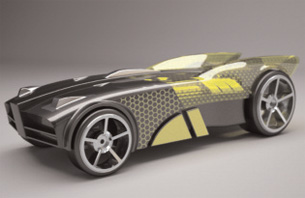 A final 3D rendering of the completed digital model in Photoshop illustrates detail in this toy. |
As an industrial designer for more than 10 years, I have come to rely on Photoshop CS3 Extended as the most important component in my process for designing quality products. It links each phase of a design project and ensures that the final product is done right and on time.
Our design consultancy, The Outside, located in Jericho, VT, offers high-end digital design and finished 3D modeling, and Photoshop is an absolute requirement in our day-to-day function. We use it for everything from sketching and early concept generation to the creation of finished presentation art. It is both an irreplaceable ideation tool and a powerful communication medium for my clients.
To begin any project, I draw a concept sketch using Photoshop on a Wacom Cintiq tablet. This immediately enters the job into a digital pipeline.
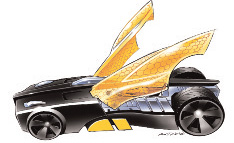 Original concept art drawn on a Cintiq tablet by designer Alec Tam. | 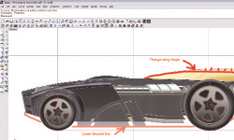 Photoshop enables comments and suggested changes to the model. |
With this seemingly simple step, Photoshop has already improved the process. Changing a sketch, adding details, or combining ideas is as simple as adding a new layer, cutting and pasting, or simply drawing it in.
Another significant benefit is the ease with which client collaboration occurs. A client can easily add a layer and redline changes, and e-mail it back. There is no verbal direction to misunderstand; the communication is crystal clear. The process happens very quickly, often with a design decision being made in minutes from across the country.
Once a design direction is chosen, sketches are imported into Rhino 3D to be used as reference while building the 3D model. This makes capturing the client’s design intent easy. Since the image is right there in the Rhino modeling environment, there is no guessing. Eliminating guesswork or interpretation at this phase makes the difference between getting it right, or just getting it done.
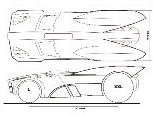 This is the original control art sent to theconsultant by Hotwheels designer Alec Tam. |
As the 3D model progresses, screenshot images are generated from Rhino in ortho and perspective views. These images are e-mailed to the client for review and marked up if necessary. Again, Photoshop is the tool that keeps the process moving. The client receives the images, adds a layer with his or her comments, and e-mails it back. These new images are imported directly into Rhino where even the smallest nuance is both clearly visible and easily captured.
This process is repeated until the model is complete and the client is happy. It is an essential aspect of how I connect with a customer to ensure that the resulting model is exactly what the client had pictured in his or her head.
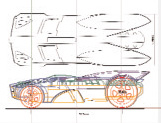 Once the concept art is imported into Rhino 3D, it can be combined with the control artand details added to create a 3D models. |
Often in complicated models or with designs that have less clear definition, Photoshop is used to quickly pose a solution. I can export a screenshot of a product model and, using Photoshop, retouch the image to try an idea or solution to a problem. If it works, I e-mail it to the client for approval. He can either OK that idea, or quickly add his input to the image. This type of “visual problem solving” using Photoshop is both extremely efficient and effective.
Since Photoshop CS3 Extended can now display and edit 2D textures in relation to 3D objects, this process is further enhanced. Instead of modeling several variations, now things like vent styles, button placement, and even ergonomic considerations can be explored quickly. Once these images are reviewed, and possibly even tested in market research, completing the model is as simple as importing the final image into Rhino as a guide for creating the final approved geometry.
A similar workflow is used after the model geometry is completed to pick the right color, texture, and graphic treatments. One version of the 3D model is textured in Rhino and then exported to Photoshop CS3 Extended for further variation. Once the model is in Photoshop, changing the decoration treatment on a model is as simple as painting on the imported 2D maps. A single map can be quickly manipulated in Photoshop to create several different versions of a design. Since you can see what the map looks like right within the Photoshop environment, you can make an artistic judgment right there.
In the past, you would have had to export the map, apply it in the 3D application, render it, and then decide if you liked it. If not, then you had to repeat the process. Now if it looks bad, you know right away. This hacks out huge chunks of time that, in the past, were essentially wasted just to see if an idea is going to fly.
Other less obvious uses for this technology are for visualizing actual geometry design variations. For instance, let’s say a client is undecided on what button shape looks best for a new mp3 player it plans to manufacture. Instead of investing the time to build several 3D models, a designer can use Photoshop CS3 Extended to very quickly paint these details on a model, use a bump map to simulate the shape of the button, and output several design variations to show to the client. Once the client picks a design, that art can be imported into a 3D application like Rhino and used as a template to create the real geometry. That way the process is always moving forward, and no geometry is harmed in the creation of the final design.
This goes beyond just getting to one solution though. This type of workflow can be used to quickly create images for market research. You can use this type of workflow to gauge a consumer’s preference in focus groups or market research. It is all about using the right tools to make the right decisions.
For me, Photoshop has, is, and will continue to be the right tool for the job. Other tools and software will come and go, but with Photoshop, Adobe has consistently delivered solutions that allow designers, artists, and marketing groups to redefine the cutting edge.
More Info:
Photoshop
Adobe Systems, Inc.
San Jose, CA
Rhino
Robert McNeel & Associates
Seattle, WA
The Outside
Jericho, VT
Kyle Houchens is an industrial designer currently designing toy cars for a well-known toy maker. He is also the owner of The Outside, a high-tech digital design consultancy specializing in the conception, development, and production of consumer products. Send comments about this article via e-mail to [email protected].
Subscribe to our FREE magazine, FREE email newsletters or both!
Latest News
About the Author
DE’s editors contribute news and new product announcements to Digital Engineering.
Press releases may be sent to them via [email protected].






